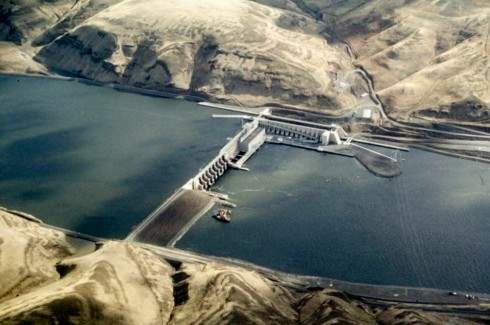forum
library
tutorial
contact

Groups Seek Pause in Long-Running
Columbia River Basin Salmon Dispute
by Todd Milbourn
Oregon Public Broadcasting, August 4, 2022
|
the film forum library tutorial contact |

|
Groups Seek Pause in Long-Running
by Todd Milbourn
|
From 7.5 to 16 million adult salmon and steelhead once swam the region's waterways,
providing food for over 130 wildlife species, such as orca, bears and wolves.
 A legal dispute over the impact of hydroelectric dams on salmon runs in the Columbia River Basin has been winding its way through federal court for more than 25 years.
A legal dispute over the impact of hydroelectric dams on salmon runs in the Columbia River Basin has been winding its way through federal court for more than 25 years.
It's been on hold for the past year while stakeholders develop a long-term plan that protects fish while safeguarding the region's power system.
On Thursday, a coalition of tribes, environmental groups and the U.S. government asked a federal judge for another year to craft that vision.
Supporters say "business as usual is not an option" as they seek to restore historic runs of salmon and other fish. They say the construction of more than a dozen dams has made it hard -- and often impossible -- for salmon to swim from Northwest rivers to the ocean and back.
"Salmon are running out of time and barreling toward extinction," said Erin Farris-Olsen, regional executive director of the National Wildlife Foundation, in a statement. "Time is of the essence."
The request follows the release of a federal report that found removing some dams on the lower Snake River -- a tributary of the Columbia -- might be required to restore salmon runs to historic levels. According to the federal government, anywhere from 7.5 to 16 million adult salmon and steelhead once swam the region's waterways, providing food for over 130 wildlife species, such as orca, bears and wolves.
Republican lawmakers including Jaime Herrera Beutler (R-Wash.) and Cliff Bentz (R-Ore.) wrote a letter to federal officials in support of keeping dams on the lower Snake.
"The infrastructure on the Columbia River System provides invaluable benefits to the Pacific Northwest, including carbon-free energy, flood control mitigation, irrigation, navigation, and recreation benefits," the lawmakers wrote in a statement. "Balancing these vital interests with species conservation is not an easy task. It is made significantly more difficult when science and collaboration is replaced by politically-motivated intervention."
Federal officials say it would be possible to replace the energy lost by removing hydroelectric dams and it would cost $11 billion to $19 billion.
Related Sites:
Survey Methodology
learn more on topics covered in the film
see the video
read the script
learn the songs
discussion forum
